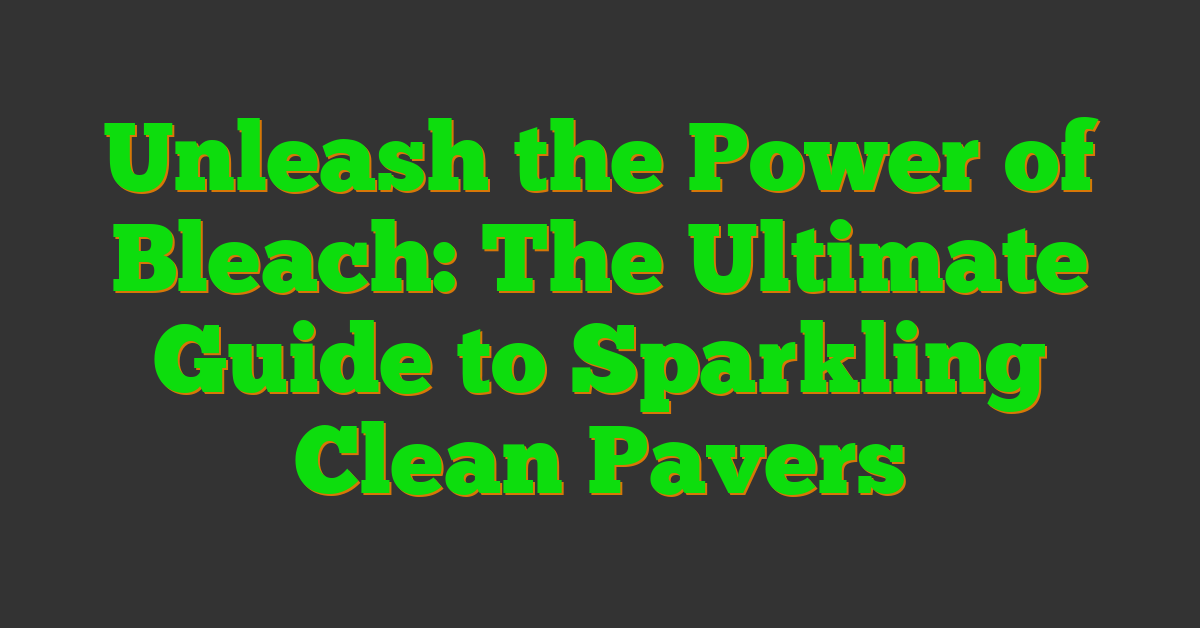If you’re looking to revitalize your outdoor space and give your pavers a fresh new look, using bleach can be a game-changer. We all know how quickly pavers can accumulate dirt, grime, and even mold, making them look worn out and neglected. With a simple solution of bleach and water, we can easily restore the original beauty of our pavers without breaking a sweat.

In our upcoming article, we’ll explore the wonders of cleaning pavers with bleach, sharing tips, tricks, and best practices to achieve stunning results. Say goodbye to stubborn stains and hello to a pristine patio or walkway that will impress your guests and elevate your outdoor living experience. Join us as we delve into the world of paver cleaning and discover how a little bleach can go a long way in transforming your outdoor oasis.
Understanding the Use of Bleach on Pavers
The Benefits of Cleaning with Bleach
When it comes to revitalizing outdoor pavers, using bleach can be a game-changer. It’s a cost-effective solution that efficiently tackles tough stains, mold, and mildew that often plague outdoor surfaces. With just a simple mixture of bleach and water, we can achieve remarkable results in transforming the appearance of pavers. Bleach not only restores the original beauty of the pavers but also helps in maintaining their longevity. As landscape designers, we have seen firsthand how a careful bleach treatment can breathe new life into worn-out pavers, making them look brand new.
Potential Risks and Precautions
While bleach is a potent cleaner, it’s essential to handle it with care, especially when working with outdoor pavers. One of the primary risks of using bleach is its corrosive nature, which can damage surrounding vegetation if not used correctly. As landscape designers, we always recommend taking necessary precautions such as wearing protective gear like gloves and goggles when handling bleach. Additionally, it’s crucial to dilute bleach properly to avoid any potential discoloration or damage to the pavers. By following these precautions, we can ensure a safe and successful paver cleaning process that enhances the overall outdoor aesthetic.
Preparing the Area for Cleaning
Safety Measures When Working with Bleach
As landscape designers, we understand the importance of implementing safety measures when working with bleach to clean pavers effectively. Before starting the cleaning process, it’s crucial to prioritize safety to ensure a smooth and hazard-free experience. Here are essential safety precautions to follow:
- Protective Gear: It’s vital to wear appropriate protective gear when handling bleach. This includes gloves, eye protection, and clothing that covers your skin to prevent any contact with the bleach solution.
- Adequate Ventilation: When using bleach, ensure that the area where you’re working is well-ventilated. This helps disperse fumes and reduces the risk of inhaling harmful vapors.
- Avoid Contact with Vegetation: Bleach can be corrosive and harmful to plants and grass. To protect surrounding vegetation from damage, consider watering the plants thoroughly before and after cleaning the pavers. Additionally, use a tarp or plastic sheeting to cover sensitive plants during the cleaning process.
- Proper Dilution: Always follow the manufacturer’s instructions for diluting bleach. Use the correct ratio of bleach to water to create an effective cleaning solution while minimizing risks.
Assembling Cleaning Supplies and Equipment
Before cleaning your pavers with bleach, it’s essential to gather all the necessary supplies and equipment. Having everything prepared ensures a smooth cleaning process and helps achieve optimal results. Here’s a list of items you’ll need:
- Bleach: Choose a high-quality bleach suitable for outdoor cleaning purposes. Ensure it is chlorine bleach as other types may not be as effective.
- Water: You’ll need water to dilute the bleach and create a cleaning solution. Use clean water for the best results.
- Bucket: A sturdy bucket will be needed to mix the bleach solution. Opt for a container that is large enough to hold an adequate amount of the cleaning solution.
- Protective Gear: As mentioned earlier, do not forget to wear protective gear, including gloves and eye protection, to safeguard yourself during the cleaning process.
- Scrub Brush: A durable scrub brush or stiff bristle broom will assist in scrubbing and removing tough stains from the pavers.
- Hose or Pressure Washer: A hose with a nozzle attachment or a pressure washer can help rinse off the bleach solution and thoroughly clean the pavers.
By following these safety measures and assembling the necessary supplies and equipment, we can ensure a smooth and successful paver cleaning process using bleach. This preparation sets the foundation for rejuvenating outdoor spaces and enhancing the beauty of pavers effectively.
Step-by-Step Guide to Clean Pavers with Bleach
Creating the Bleach Cleaning Solution
When it comes to cleaning pavers with bleach, the first step is to create the cleaning solution. For this task, we’ll need to mix bleach with water. It’s important to use the correct ratio for an effective and safe cleaning process. Typically, we recommend mixing one part bleach with ten parts water. This dilution ensures that the bleach is potent enough to clean the pavers without causing any damage.
Application: How to Properly Apply the Solution
Once the bleach cleaning solution is ready, the next step is its proper application. We suggest starting by testing a small, inconspicuous area of the pavers to ensure that the solution doesn’t cause any adverse effects. If the test is successful, apply the bleach solution generously over the pavers using a sprayer or a watering can. Allow the solution to sit on the surface for about 10-15 minutes to penetrate and lift the dirt, mold, and stains effectively.
Scrubbing Techniques for Effective Cleaning
After allowing the bleach solution to work its magic, the next crucial step is to scrub the pavers. Using a stiff-bristled scrub brush, we recommend scrubbing the surface in a circular motion to dislodge stubborn dirt and grime. Pay close attention to areas with deep stains or mold growth. The scrubbing action will help lift the embedded dirt, ensuring a thorough cleaning process.
Rinsing and Neutralizing the Pavers
Once the pavers have been thoroughly scrubbed, it’s time to rinse and neutralize the bleach. Use a hose or a pressure washer to rinse off the bleach solution thoroughly. Make sure to rinse the pavers multiple times to remove all traces of bleach. After rinsing, prepare a neutralizing solution by mixing water with a small amount of vinegar. Apply this solution over the pavers to neutralize any remaining bleach residue and restore the pH balance of the surface.
This step-by-step guide provides a comprehensive approach to cleaning pavers with bleach effectively and safely. By following these instructions, you can rejuvenate your outdoor pavers and enhance the overall appearance of your outdoor space.
Aftercare: Maintaining Clean Pavers
Regular Cleaning Routine
When it comes to preserving the pristine look of your pavers, incorporating a regular cleaning routine is essential. We recommend a monthly cleaning schedule to prevent the buildup of dirt and grime, ensuring that your outdoor pavers maintain their fresh appearance throughout the year.
To maintain clean pavers, simply follow these easy steps:
- Sweep Regularly: Start by sweeping your pavers to remove loose debris and dirt. This simple step prevents dirt from settling into the crevices, keeping your outdoor space looking neat and tidy.
- Spot Treat Stains: Address any stains promptly by spot treating them with a bleach solution. This proactive approach prevents stains from becoming deeply embedded in the pavers, making them easier to remove during your regular cleaning routine.
- Rinse Thoroughly: After spot treating stains, ensure you thoroughly rinse the pavers with clean water to remove any residue. This step helps maintain the cleanliness of your outdoor pavers and prevents the accumulation of cleaning product residues.
By incorporating these simple steps into your regular cleaning routine, you can ensure that your pavers remain in top condition, enhancing the beauty of your outdoor space.
Sealing Pavers for Long-Term Protection
To provide long-term protection for your pavers and enhance their durability, sealing them is a crucial step in your maintenance routine. Sealing outdoor pavers helps prevent stains, inhibits the growth of mold and mildew, and protects the pavers from the damaging effects of UV rays and harsh weather conditions.
Follow these steps to seal your pavers effectively:
- Choose the Right Sealer: Select a high-quality sealer suitable for your paver material. The type of sealer you choose will depend on whether your pavers are porous or non-porous, so be sure to read the manufacturer’s recommendations for the best results.
- Clean the Surface: Before sealing your pavers, ensure they are clean and free of any dirt, grime, or stains. Use a mild detergent and water solution to clean the pavers thoroughly, allowing them to dry completely before applying the sealer.
- Apply the Sealer: Using a brush or roller, apply the sealer evenly across the surface of the pavers. Be sure to follow the manufacturer’s instructions regarding the application process, including how many coats to apply and the drying time between coats.
- Allow for Drying Time: After applying the sealer, allow sufficient time for it to dry completely. This step is crucial to ensure that the sealer bonds effectively with the pavers, providing long-lasting protection and enhancing their appearance.
By sealing your pavers regularly, you can extend their lifespan, enhance their color and finish, and protect them from external elements, ensuring that your outdoor space remains beautiful and inviting for years to come.
Alternatives to Bleach for Eco-Friendly Cleaning
Natural Cleaning Solutions
As landscape designers, we understand the importance of maintaining the beauty of outdoor spaces while being mindful of the environment. When it comes to cleaning pavers in an eco-friendly way, we recommend exploring natural cleaning solutions that are safe and effective.
« Ultimate Guide: Transform Your Driveway with Expert Paver Laying Techniques Unveiling the Secret: How Pavers Transform and Skyrocket Your Home’s Value »
One alternative to bleach is a mixture of white vinegar and water. This simple solution can help remove dirt, mold, and mildew from pavers without harming surrounding plants or wildlife. By mixing equal parts of vinegar and water in a spray bottle and applying it to the affected areas, you can achieve a clean and refreshed look for your outdoor pavers.
Another natural option is using baking soda. Baking soda is known for its gentle abrasive properties, making it ideal for scrubbing away tough stains on pavers. By creating a paste with baking soda and water and applying it to the stains, you can effectively lift dirt and grime without the need for harsh chemicals.
Commercial Eco-Friendly Products
In our practice, we often recommend commercial eco-friendly products for clients looking for convenient and sustainable solutions for cleaning outdoor pavers. These products are specifically formulated to be gentle on the environment while providing effective cleaning results.
One popular eco-friendly product is a plant-based cleaner. These cleaners use natural ingredients derived from plants to break down dirt and grime on pavers without leaving behind harmful residues. They are biodegradable and safe to use around children and pets, making them a great choice for maintaining outdoor spaces.
Another option is enzyme-based cleaners. Enzymes are biological molecules that help break down organic matter, making them effective for removing stains and odors from pavers. Enzyme-based cleaners are non-toxic and environmentally friendly, offering a sustainable cleaning solution for outdoor surfaces.
By exploring these natural cleaning solutions and eco-friendly products, we can ensure that outdoor pavers stay clean, beautiful, and environmentally conscious for years to come.
Conclusion
We’ve explored the wonders of using bleach to revitalize outdoor pavers, highlighting its remarkable ability to banish dirt, grime, mold, and stains. Remember, safety first! Our step-by-step guide ensures a seamless cleaning process. Looking beyond bleach, we’ve uncovered eco-friendly alternatives like white vinegar, baking soda, and plant-based or enzyme cleaners. These options promise a spotless finish while being kind to our planet. Keep your outdoor pavers gleaming with these environmentally conscious choices.












